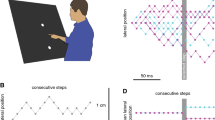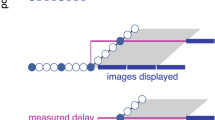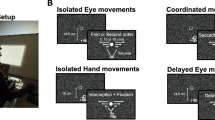Abstract
People make rapid, goal-directed movements to interact with their environment. Because these movements have consequences, it is important to be able to control them with a high level of precision and accuracy. Our hypothesis is that vision guides rapid hand movements, thereby enhancing their accuracy and precision. To test this idea, we asked observers to point to a briefly presented target (110 ms). We measured the impact of visual information on endpoint precision by using a shutter to close off view of the hand 50, 110 and 250 ms into the reach. We found that precision was degraded if the view of the hand was restricted at any time during the reach, despite the fact that the target disappeared long before the reach was completed. We therefore conclude that vision keeps the hand on the planned trajectory. We then investigated the effects of a perturbation of target position during the reach. For these experiments, the target remained visible until the reach was completed. The target position was shifted at 110, 180 or 250 ms into the reach. Early shifts in target position were easily compensated for, but late shifts led to a shift in the mean position of the endpoints; observers pointed to the center of the two locations, as a kind of best bet on the position of the target. Visual information is used to guide the hand throughout a reach and has a significant impact on endpoint precision.










Similar content being viewed by others
References
Batista AP, Buneo CA, Snyder LH, Andersen RA (1999) Reach plans in eye-centered coordinates. Science 285(5425):257–260
Bedard P, Proteau L (2004) On-line vs. off-line utilization of peripheral visual afferent information to ensure spatial accuracy of goal-directed movements. Exp Brain Res 158(1):75–85
Brainard DH (1997) The psychophysics toolbox. Spat Vis 10:433–436
Connolly JD Goodale MA (1999) The role of visual feedback of hand position in the control of manual prehension. Exp Brain Res 125(3):281–286
Ernst MO, Banks MS (2002) Humans integrate visual and haptic information in a statistically optimal fashion. Nature 415(6870):429–433
Harris CM, Wolpert DM (1998) Signal-dependent noise determines motor planning. Nature 394(6695):780–784
Henriques DY, Klier EM, Smith MA, Lowy D, Crawford JD (1998) Gaze-centered remapping of remembered visual space in an open-loop pointing task. J Neurosci 18(4):1583–1594
Jeannerod M (1988) The neural and behavioural organization of goal-directed hand movements. Clarendon Press, Oxford
Keele SW, Posner MI (1968) Processing of visual feedback in rapid movements. J Exp Psychol 77(1):155–158
Kitazawa S, Kohno T, Uka T (1995) Effects of delayed visual information on the rate and amount of prism adaptation in the human. J Neurosci 15(11):7644–7652
Komilis E, Pelisson D, Prablanc C (1993) Error processing in pointing at randomly feedback-induced double-step stimuli. J Motor Behav 25(4):299–308
Kording KP, Wolpert D (2004) Bayesian integration in sensorimotor learning. Nature 427:244–247
Maljkovic V, Nakayama K (1996) Priming of pop-out: II. The role of position. Percept Psychophys 58(7):977–991
Maloney L, Dal Martello MF, Sahm C, Spillmann L (2005) Past trials influence perception of ambiguous motion quartets through pattern completion. Proc Natl Acad Sci USA 102(8):3164–3169
Ma-Wyatt A, McKee SP (2006) Initial visual information determines endpoint precision for rapid pointing. Vision Res (in press)
McIntyre J, Stratta F, Lacquaniti F (1998) Short-term memory for reaching to visual targets: psychophysical evidence for body-centered reference frames. J Neurosci 18(20):8423–8435
McPeek RM, Maljkovic V, Nakayama K (1999) Saccades require focal attention and are facilitated by a short-term memory system. Vis Res 39(8):1555–1566
Paillard J (1996) Fast and slow feedback loops for the visual correction of spatial errors in a pointing task: a reappraisal. Can J Physiol Pharmacol 74:401–417
Pelli DG (1997) The VideoToolbox software for visual psychophysics: transforming numbers into movies. Spat Vis 10:437–442
Rossetti Y, Stelmach G, Desmurget M, Prablanc C, Jeannerod M (1994) The effect of viewing the static hand prior to movement onset on pointing kinematics and variability. Exp Brain Res 101(2):323–330
Saunders JA, Knill DC (2003) Humans use continuous visual feedback from the hand to control fast reaching movements. Exp Brain Res 152(3):341–352
Saunders JA, Knill DC (2004) Visual feedback control of hand movements. J Neurosci 24(13):3223–3234
Sheth BR, Shimojo S (2002) How the lack of visuomotor feedback affects even the earl stages of goal-directed pointing movements. Exp Brain Res 143:181–190
Sober SJ, Sabes PN (2003) Multisensory integration during motor planning. J Neurosci 23(18):6982–6992
Sober SJ, Sabes PN (2005) Flexible strategies for sensory integration during motor planning. Nat Neurosci 8(4):490–497
Trommershauser J, Maloney LT, Landy MS (2003) Statistical decision theory and the selection of rapid, goal-directed movements. J Opt Soc Am Image Sci Vis 20(7):1419–1433
van Beers RJ, Baraduc P, Wolpert DM (2002) Role of uncertainty in sensorimotor control. Philos Trans R Soc Lond B Biol Sci 357(1424):1137–1145
White JM, Levi DM, Aitsebaomo AP (1992) Spatial localization without visual references. Vision Res 32(3):513–526
White JM, Sparks DL, Stanford TR (1994) Saccades to remembered target locations: an analysis of systematic and variable errors. Vision Res 34(1):79–92
Whitney D, Westwood DA, Goodale MA (2003) The influence of visual motion on fast reaching movements to a stationary object. Nature 423:869–873
Wolpert DM, Ghahramani Z, Jordan MI (1995) An internal model for sensorimotor integration. Science 269(5232):1880–1882
Acknowledgments
This work was supported by a Rachel C. Atkinson Fellowship to A.M.W. and NEI EY06644 to S.P.M. The authors thank Preeti Verghese and Laura Renninger for valuable discussions, and Doug Taylor for valuable assistance with shutter wrangling.
Author information
Authors and Affiliations
Corresponding author
Rights and permissions
About this article
Cite this article
Ma-Wyatt, A., McKee, S.P. Visual information throughout a reach determines endpoint precision. Exp Brain Res 179, 55–64 (2007). https://doi.org/10.1007/s00221-006-0767-1
Received:
Accepted:
Published:
Issue Date:
DOI: https://doi.org/10.1007/s00221-006-0767-1




